(Editor’s Note: The Mad Scientist Laboratory is pleased to present Part II of Mr. Nick Marsella’s guest blog post. To read Part I, select this link. If you are interested in submitting a guest post, please select “Guest Bloggers” from the menu above and review the submission instructions)
One of the most critical questions that often gets lost in the passionate pronouncements by those thinking about the future, is why their assessment of a future technology, scenario or trend is important? Some researchers, such as those in academia or some think tanks, can pursue the “future” with a great deal of freedom in the discovery of new knowledge. However, for those “futurists” in Government [and specifically those associated with the military], they face decision makers who need to focus on the “so what?”
As the National Academy of Sciences noted: “A useful forecast provides insights that lead to effective action in the present.”1 Some decisions and actions will include what, when, and how to acquire or invest in technologies or to make organizational changes for the near or midterm [0 to 15 years], while others point to areas for investment in research and development for the far future.
Our estimates, trends analysis and forecasts, and recommended actions such as the adoption of specific technologies, are normally designed to solve one or more of these problem frames:

Our descriptions of the future or of a technology must be clear [avoiding “jargon-monoxide”], concise, and identify the implications for the force, what problem it will solve, what action(s) we recommend, and most importantly the assumptions we are making as well as the risk and confidence we have in our assessment.
For U.S. military forces, with a worldwide mission, some of the questions which often provoke a solution include:
– What capabilities2 do I need which can enhance my capabilities (across many specific functions)?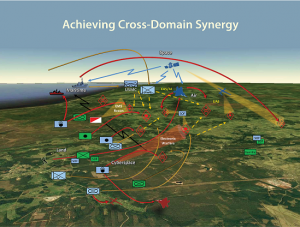
– What capabilities provide or sustain overmatch in my capabilities (e.g., lethality)?
– What capabilities produce an asymmetric advantage?
– What capabilities reduce manpower and costs?
– What capabilities will enable forces [or technology] to operate in all conditions (or maximize abilities to operate in a specific terrain (e.g., dense urban operations)?
In order to be successful in fielding capabilities to solve one of these problem frames, organizations need both a “vision of the future” in order to identify requirements and a system to constantly scan for developments and trends. As General Dempsey, former Commander of U.S. Army Training and Doctrine Command, noted in 2011: “Great organizations learn by continually challenging what they are doing, questioning the assumptions and premises underlying their choices, and identifying potential vulnerabilities, weaknesses, and seeking out alternative approaches, solutions and perspectives.”3
As many experts have noted, an organization must have an effective scanning and sifting process to constantly review new developments in their environment(s) in order to discover ways to build capabilities and to prevent surprise. Our aperture to capture the future must be wide – as Day and Shoemaker (2005) noted – to the “periphery – where the biggest dangers are the ones you don’t see coming.”4  In addition to having a wide aperture looking across timeframes by tapping into all available networks and by establishing and mobilizing search parties, such as the Mad Scientist initiative [Day and Schoemaker used the analogy of a “crow’s nest”], we must be (1) open minded; (2) take a deep dive on the most worrisome findings through such techniques as red vs. blue analysis, and (3) maintain an inherent red teaming process throughout the effort to challenge the finding, insight, observation or recommendation for action.5
In addition to having a wide aperture looking across timeframes by tapping into all available networks and by establishing and mobilizing search parties, such as the Mad Scientist initiative [Day and Schoemaker used the analogy of a “crow’s nest”], we must be (1) open minded; (2) take a deep dive on the most worrisome findings through such techniques as red vs. blue analysis, and (3) maintain an inherent red teaming process throughout the effort to challenge the finding, insight, observation or recommendation for action.5
 Surprises will happen, especially in the technology arena. The creation of new knowledge is not confined to the U.S. given the globalization of technology. As the Defense Science Board noted in 2009 – having the ability to make “really bad things happen” is no longer the sole province of a few major states. Yet, as we often focus on “game changing” or “disruptive future technologies,” Dr. Paul Bracken of Yale University reminds us that old technology used differently or a combination of old technologies combined can be just as dangerous as new technologies.
Surprises will happen, especially in the technology arena. The creation of new knowledge is not confined to the U.S. given the globalization of technology. As the Defense Science Board noted in 2009 – having the ability to make “really bad things happen” is no longer the sole province of a few major states. Yet, as we often focus on “game changing” or “disruptive future technologies,” Dr. Paul Bracken of Yale University reminds us that old technology used differently or a combination of old technologies combined can be just as dangerous as new technologies.
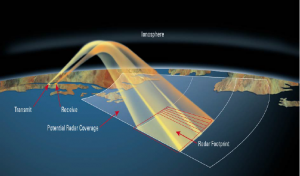
 In essence, sidewise technologies are those which combine technologies – such as missiles and Over-the-Horizon radar – to present new challenges and dangers. Even simple technologies such as those used for the IEDs of the past, current and future will challenge us, as will commercial and military unmanned systems of all types.
In essence, sidewise technologies are those which combine technologies – such as missiles and Over-the-Horizon radar – to present new challenges and dangers. Even simple technologies such as those used for the IEDs of the past, current and future will challenge us, as will commercial and military unmanned systems of all types.
Thomas Shelling, a Nobel Prize winner noted: “One thing a person cannot do, no matter how rigorous his analysis or heroic his imagination, is to draw up a list of things that would never occur to him.” We must be inquisitive seeking what Peter Schwartz noted in the Art of the Long View as “imaginative leaps into the future” to discover alternative futures.7 But we must also guard against “marching to the sound of the most recent pronouncement” about the future and avoid using experience as our guide without remaining as J.P. Clark noted both “humble and conscious of the limits of experience.”8
Futures work can be frustrating and often wrong. Futures work is important for any organization in shaping its future but only if we provide decision makers clear jargon free recommendations linked to a problem or exploitation of an unseen opportunity. We must be mindful of the cognitive diseases that affect our assessments about the future by being both humble and skeptical. As Yoda, the wise Jedi master in Star Wars noted – “Difficult to see, always in motion is the future.”
We must be mindful of the cognitive diseases that affect our assessments about the future by being both humble and skeptical. As Yoda, the wise Jedi master in Star Wars noted – “Difficult to see, always in motion is the future.”
 The Bottom line: Assessing the future is critical to remaining competitive, whether in the boardroom or battlefield. As Yogi said – “The future isn’t what it used to be.”
The Bottom line: Assessing the future is critical to remaining competitive, whether in the boardroom or battlefield. As Yogi said – “The future isn’t what it used to be.”
Nick Marsella is a retired Army Colonel and is currently a Department of the Army civilian serving as the Devil’s Advocate/Red Team for Training and Doctrine Command.
__________________________________
1 National Research Council of the National Academies. (2010). Persistent Forecasting of Disruptive Technologies — quote taken from Chapter 1.
2 While increased capabilities are often associated with the acquisition of new technologies (i.e., materiel solutions), it can also be achieved via changes to one or more of the following: Doctrine, Organization, Training, Materiel, Leadership and Education, Personnel, Facilities, and Policy (i.e., DOTMLPF-P).
3 General Dempsey made this quote in a memorandum endorsing the idea of red teaming.
4 Day, G.S. & Schoemaker, P. J.H. (2005). Scanning the Periphery. Harvard Business Review, pp 135 – 148.
5 One of the challenges for those working futures is rediscovering or what some might view as re-plowing old ground. For example, numerous reports have been published on known knows and known unknowns. For example, see Defense Science Board, Capability Surprise Summer Study 2008, Volume I: Main Report, September 2009 and Volume II: Supporting Papers, January 2010; Freier, N. (2008). Known Unknowns: Unconventional “Strategic Shocks” in Defense Strategy Development, Army War College, Strategic Studies Institute; Leed, M., Price, H., & Murphy, T. (2010). Surprise is Inevitable; Vulnerability is Not: Improving the Defense Department’s Readiness to Address Key Areas of Potential Surprise. Washington D.C.: Center for Strategic and International Studies; and official publications such as National Intelligence Council. (2017) Global Trends: Paradox of Progress.
6 Bracken, P. (2008). Technological Innovation and National Security. Foreign Policy Research Institute (FPRI) E-Notes.
7 Schwartz, P. (2006). The Art of the Long View: Planning for the Future in an Uncertain World. New York: Doubleday.
8 Clark, J.P. (2016, Autumn). Adapting to Strategic Change, Parameters, Carlisle Barracks, PA: U.S. Army War College.

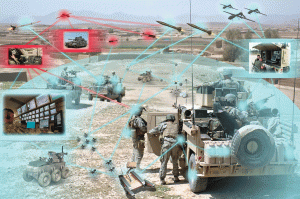 All things in the future OE will be smart, connected, and self-organizing. The commercial Internet of Things (IoT) will turn into a militarized Internet of Battle Things (IoBT).
All things in the future OE will be smart, connected, and self-organizing. The commercial Internet of Things (IoT) will turn into a militarized Internet of Battle Things (IoBT). Narrow Artificial Intelligence (AI) is here today and is beginning to show up on the battlefield. Near peer competitors and non-state actors will have access to these technologies on pace with the United States due to commercial and open source availability of algorithms.
Narrow Artificial Intelligence (AI) is here today and is beginning to show up on the battlefield. Near peer competitors and non-state actors will have access to these technologies on pace with the United States due to commercial and open source availability of algorithms.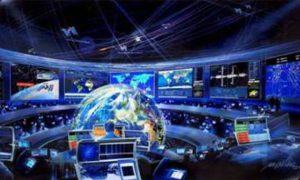 AI and humans must co-evolve. It is not clear that the singularity (i.e., AI leading to a “runaway reaction” of self-improvement cycles, ultimately resulting in a super intelligence far surpassing human intelligence) will be realized in the period leading up to 2050. Human teaming with AI enablers will be the best instantiation of general intelligence supporting Commanders on the future battlefield. Next steps towards singularity are systems that can reflect, have curiosity, and demonstrate teamwork.
AI and humans must co-evolve. It is not clear that the singularity (i.e., AI leading to a “runaway reaction” of self-improvement cycles, ultimately resulting in a super intelligence far surpassing human intelligence) will be realized in the period leading up to 2050. Human teaming with AI enablers will be the best instantiation of general intelligence supporting Commanders on the future battlefield. Next steps towards singularity are systems that can reflect, have curiosity, and demonstrate teamwork. The physical and virtual spaces will merge. Augmented and virtual reality will become more than a gaming platform focused on entertainment but a global communication platform delivering unique expertise to the battlefield to include medical and language skills.
The physical and virtual spaces will merge. Augmented and virtual reality will become more than a gaming platform focused on entertainment but a global communication platform delivering unique expertise to the battlefield to include medical and language skills.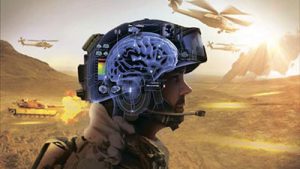 Convergence is a key attribute in all aspects of the future battlefield. Expect convergence of capability, sensors, power onto systems, uniforms, and in the far term humanity itself.
Convergence is a key attribute in all aspects of the future battlefield. Expect convergence of capability, sensors, power onto systems, uniforms, and in the far term humanity itself. The next fight will be characterized by electrons vs electrons. All belligerents will seek to hide themselves and blind their enemies. The fight after next will be characterized by AI vs AI (algorithm vs algorithm). How AI is structured and integrated will be the strategic advantage.
The next fight will be characterized by electrons vs electrons. All belligerents will seek to hide themselves and blind their enemies. The fight after next will be characterized by AI vs AI (algorithm vs algorithm). How AI is structured and integrated will be the strategic advantage. Information Warfare is taking on new meaning. Humans now have a personal relationship with their information and virtual reality and holograms in your living room will create new opportunities for swaying populations.
Information Warfare is taking on new meaning. Humans now have a personal relationship with their information and virtual reality and holograms in your living room will create new opportunities for swaying populations. Major competitions in the war after next include – cyber-attack vs AI, stealth vs detection, directed energy vs hardening, space vs counter-space, strikers vs shielders.
Major competitions in the war after next include – cyber-attack vs AI, stealth vs detection, directed energy vs hardening, space vs counter-space, strikers vs shielders. We are in a 10 year window of a change in how we think about space. Space is now competitive as
We are in a 10 year window of a change in how we think about space. Space is now competitive as  There is a real tension between the idea that ubiquitous sensors and real time upload of data onto the cloud will make it impossible to hide and that the near equal access of capabilities across all parties will make war constant.
There is a real tension between the idea that ubiquitous sensors and real time upload of data onto the cloud will make it impossible to hide and that the near equal access of capabilities across all parties will make war constant. The definition of maneuver should be expanded to include maneuvering ideas as well as forces to a position of advantage. A globally connected world and social media platforms have amplified the importance of ideas and the information dimension.
The definition of maneuver should be expanded to include maneuvering ideas as well as forces to a position of advantage. A globally connected world and social media platforms have amplified the importance of ideas and the information dimension.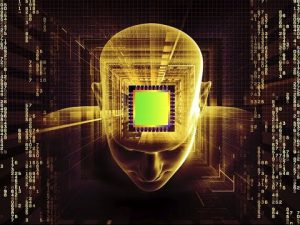 Bio convergence with advanced computing is happening at the edge. Humans will become part of the network connected through their embedded and worn devices. From transhumanism to theorizing about uploading the brain, it will not be the IoT but the internet of everything (including humans).
Bio convergence with advanced computing is happening at the edge. Humans will become part of the network connected through their embedded and worn devices. From transhumanism to theorizing about uploading the brain, it will not be the IoT but the internet of everything (including humans). Smart cities are leaving the edge and early adopters and becoming mainstream. The data collected by billions of sensors will be a treasure trove for the country and Armed forces that learn to exploit. Passive collection of this information might be a significant advantage in winning the hiders v finders competition.
Smart cities are leaving the edge and early adopters and becoming mainstream. The data collected by billions of sensors will be a treasure trove for the country and Armed forces that learn to exploit. Passive collection of this information might be a significant advantage in winning the hiders v finders competition. Cognitive enhancement and attacking the brains (neurological system) of humans is not science fiction. The U.S. Army should establish a PEO for Soldier Enhancement to bring unity of purpose to a range of capabilities from physical/mental enhancement with wearables, embeddables, stimulants, brain gyms, and exoskeletons.
Cognitive enhancement and attacking the brains (neurological system) of humans is not science fiction. The U.S. Army should establish a PEO for Soldier Enhancement to bring unity of purpose to a range of capabilities from physical/mental enhancement with wearables, embeddables, stimulants, brain gyms, and exoskeletons.  Human enhancement, the unlocking of the genome, and improving artificial intelligence will stress the Army’s policies and ethics. In any case, our 4 + 1 potential adversaries are exploring using all three of these capabilities as a way to gain advantage over U.S. Forces. This is not a 2050 problem but more than likely a 2030 reality.
Human enhancement, the unlocking of the genome, and improving artificial intelligence will stress the Army’s policies and ethics. In any case, our 4 + 1 potential adversaries are exploring using all three of these capabilities as a way to gain advantage over U.S. Forces. This is not a 2050 problem but more than likely a 2030 reality.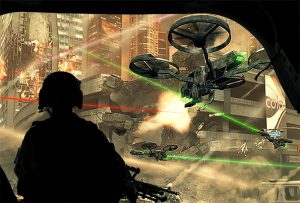 Virtually every new technology is connected and intersecting to other new technologies and advances. Convergence frequently occurred across numerous technologies. Advances in materials, AI, drones, communications, and human enhancement amplified and drove one another across multiple domains.
Virtually every new technology is connected and intersecting to other new technologies and advances. Convergence frequently occurred across numerous technologies. Advances in materials, AI, drones, communications, and human enhancement amplified and drove one another across multiple domains. A major cultural divide and gulf in understanding still existed between different populations even with developments in technology (including real-time language translators).
A major cultural divide and gulf in understanding still existed between different populations even with developments in technology (including real-time language translators).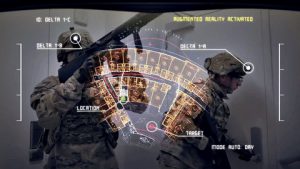 The fully enmeshed communications and sensing residing in future systems made the hiders vs. finders competition ever more important in future conflict settings.
The fully enmeshed communications and sensing residing in future systems made the hiders vs. finders competition ever more important in future conflict settings.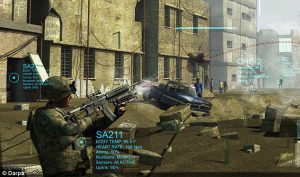 Due to the exponential speed of interaction on the battlefield (during and in between high-intensity conflict), a number of the military units required smaller formations, with large effects capabilities and more authority, and operated under flat and dispersed command and control structures.
Due to the exponential speed of interaction on the battlefield (during and in between high-intensity conflict), a number of the military units required smaller formations, with large effects capabilities and more authority, and operated under flat and dispersed command and control structures.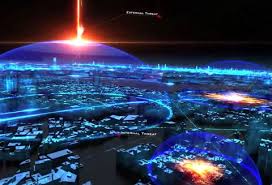 The constant battle for and over information often meant victory or failure for each side.
The constant battle for and over information often meant victory or failure for each side. 2018 is shaping up to be even more enlightening, with Mad Scientist conferences addressing Bio Convergence and Soldier 2050 and Learning in 2050. We will also support a Smart and Resilient Installations franchise event, hosted by the Army Secretariat. Stay tuned to the Mad Scientist Laboratory for more information on the year ahead!
2018 is shaping up to be even more enlightening, with Mad Scientist conferences addressing Bio Convergence and Soldier 2050 and Learning in 2050. We will also support a Smart and Resilient Installations franchise event, hosted by the Army Secretariat. Stay tuned to the Mad Scientist Laboratory for more information on the year ahead!
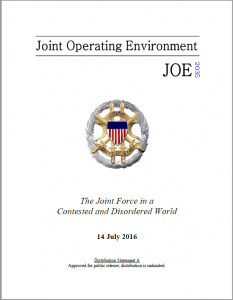 Globally Integrated Operations – that is, the ability to purposefully bring together the full panoply of joint capabilities in time and space to achieve military tasks under a broad range of strategic goals. The Joint Staff’s
Globally Integrated Operations – that is, the ability to purposefully bring together the full panoply of joint capabilities in time and space to achieve military tasks under a broad range of strategic goals. The Joint Staff’s 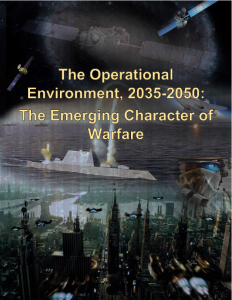 This theme was further explored in
This theme was further explored in 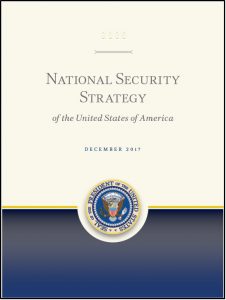 Helpfully, the new
Helpfully, the new  “… in calling Moriarty a criminal you are uttering libel in the eyes of the law, and there lies the glory and the wonder of it! The greatest schemer of all time, the organizer of every devilry, the controlling brain of the underworld — a brain which might have made or marred the destiny of nations. That’s the man!” Sir Arthur Conan Doyle’s Sherlock Holmes, describing his arch nemesis, Professor James Moriarty, in The Valley of Fear, published in 1914.
“… in calling Moriarty a criminal you are uttering libel in the eyes of the law, and there lies the glory and the wonder of it! The greatest schemer of all time, the organizer of every devilry, the controlling brain of the underworld — a brain which might have made or marred the destiny of nations. That’s the man!” Sir Arthur Conan Doyle’s Sherlock Holmes, describing his arch nemesis, Professor James Moriarty, in The Valley of Fear, published in 1914. 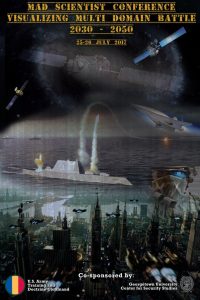 In Professor Moriarty, Conan Doyle created the prototypical Super-Empowered Individual (SEI). Today’s SEIs — far from being fictional characters crafted to entertain readers from a gentler era — are real world, non-state actors that have been empowered by the on-going digital revolution, and are able to target and adversely affect the lives of millions around the globe. Mad Scientists addressed the threat posed by SEIs at the
In Professor Moriarty, Conan Doyle created the prototypical Super-Empowered Individual (SEI). Today’s SEIs — far from being fictional characters crafted to entertain readers from a gentler era — are real world, non-state actors that have been empowered by the on-going digital revolution, and are able to target and adversely affect the lives of millions around the globe. Mad Scientists addressed the threat posed by SEIs at the 

 Wired recently reported on several Distributed Denial of Service (DDoS) attacks, launched by SEIs. This
Wired recently reported on several Distributed Denial of Service (DDoS) attacks, launched by SEIs. This 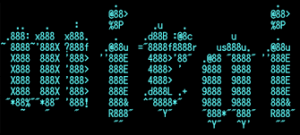
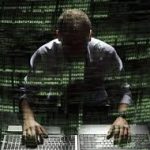 These attacks, however, need not necessarily be broad DDoS operations; SEIs can leverage these disruptive technologies to craft and execute
These attacks, however, need not necessarily be broad DDoS operations; SEIs can leverage these disruptive technologies to craft and execute 